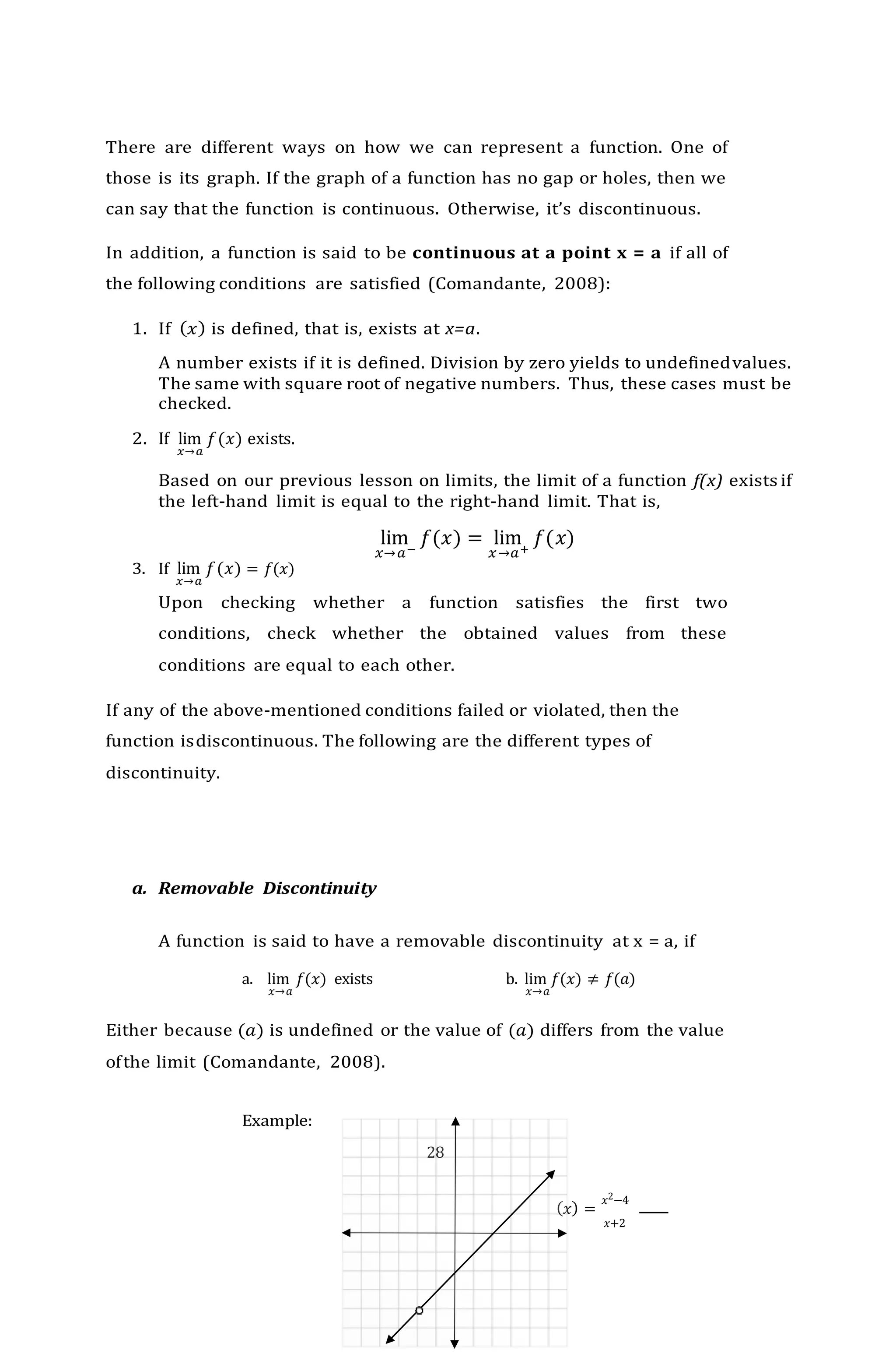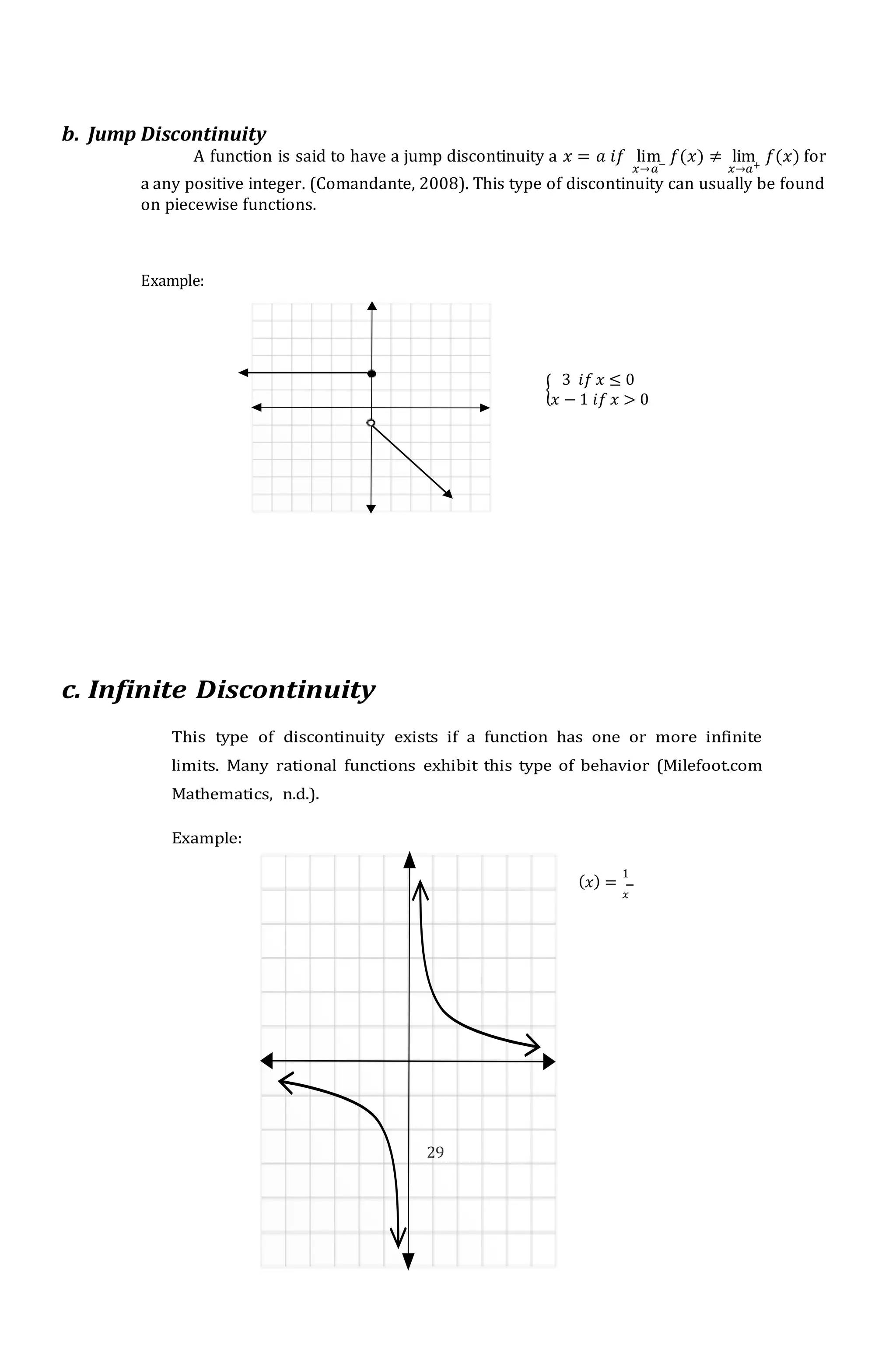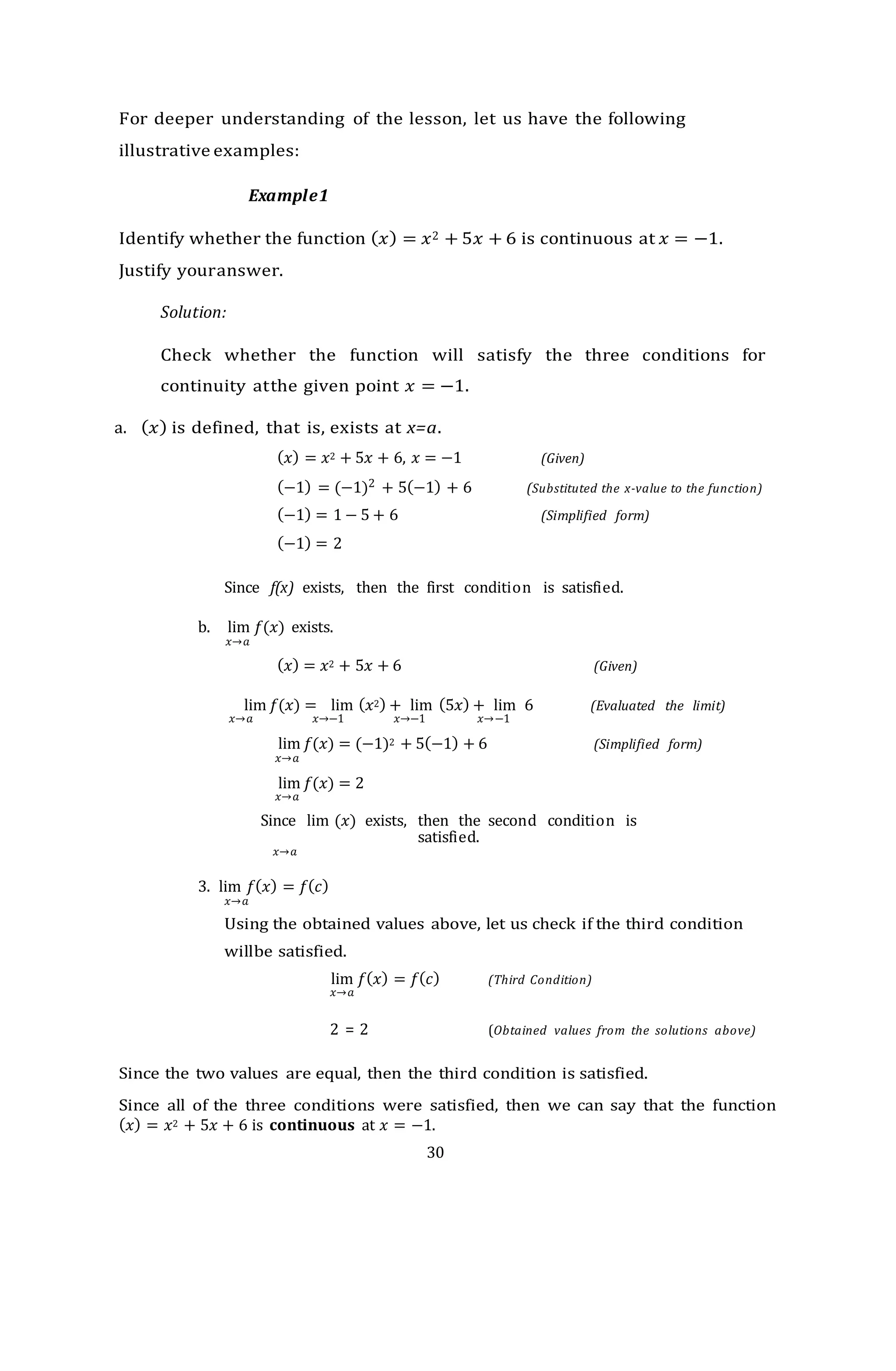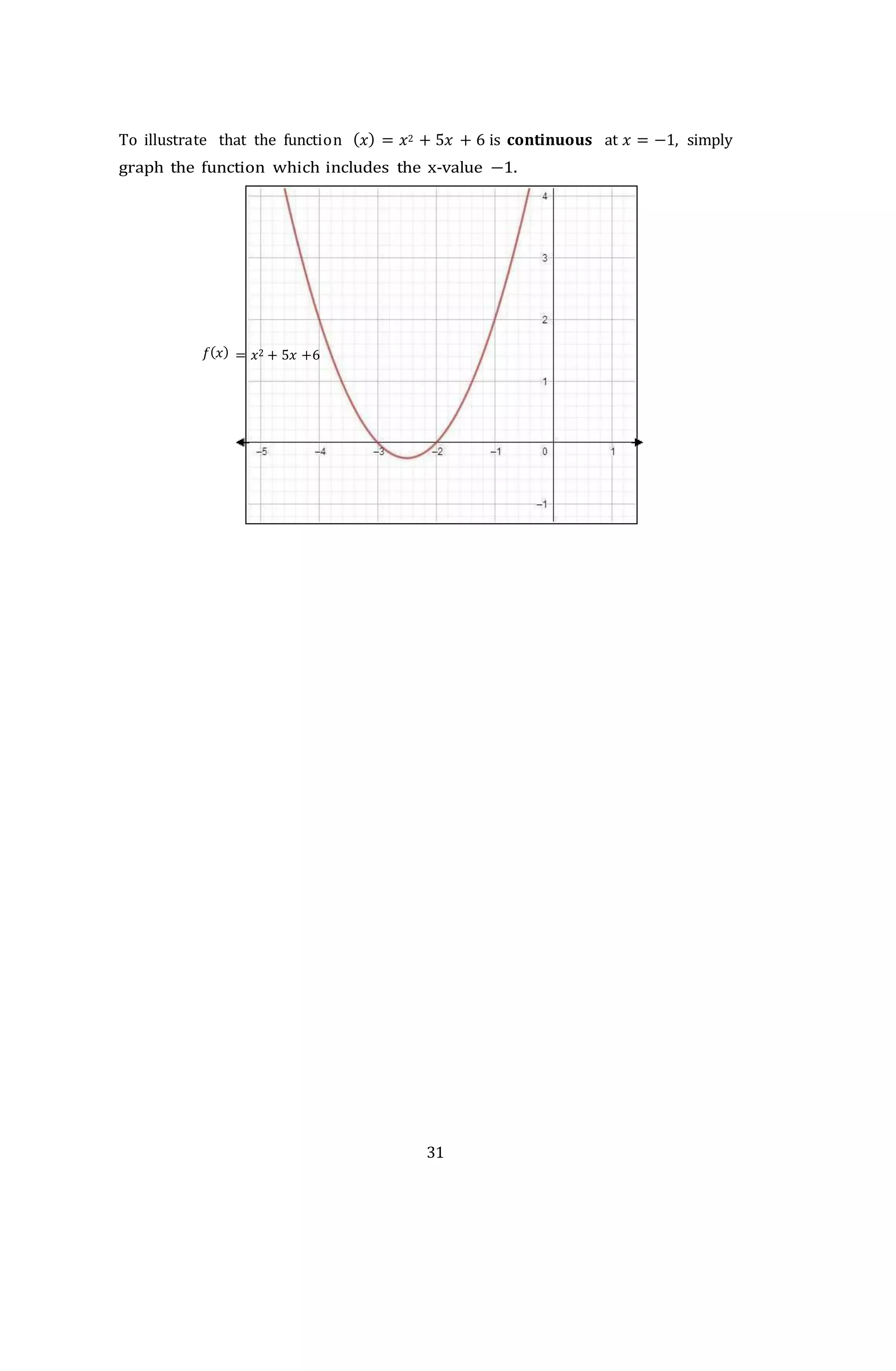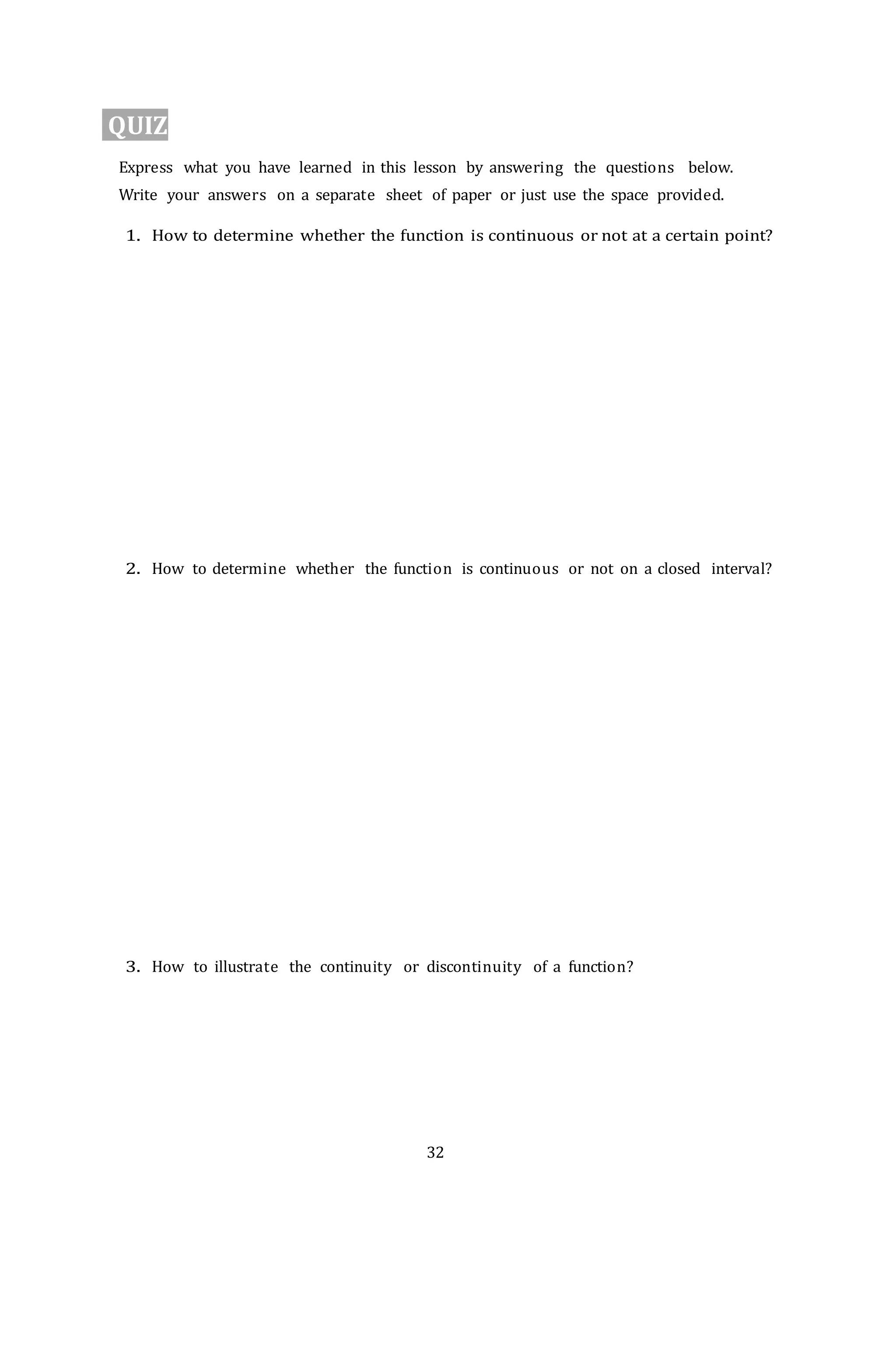The document discusses limits and how to calculate them. Some key points include:
1. Limits can be calculated by taking the values of a function as it approaches a certain number from the left and right sides. This is done by creating tables of values.
2. Common limit laws can also be used to directly calculate limits, such as the constant multiple law and addition/subtraction laws.
3. Graphing the values from the tables shows whether the limit exists as the input values approach the given number, demonstrating the value the function approaches.
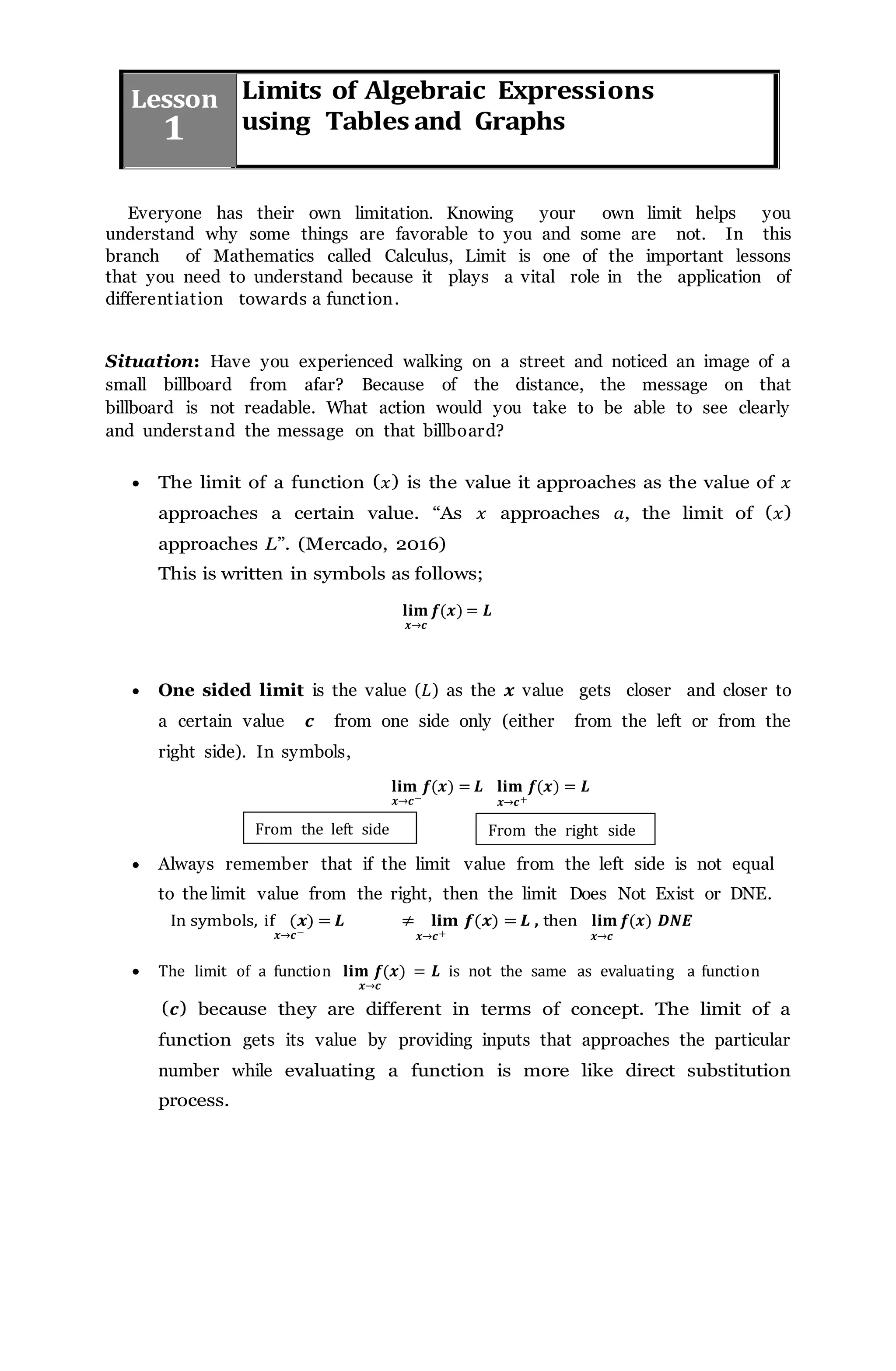
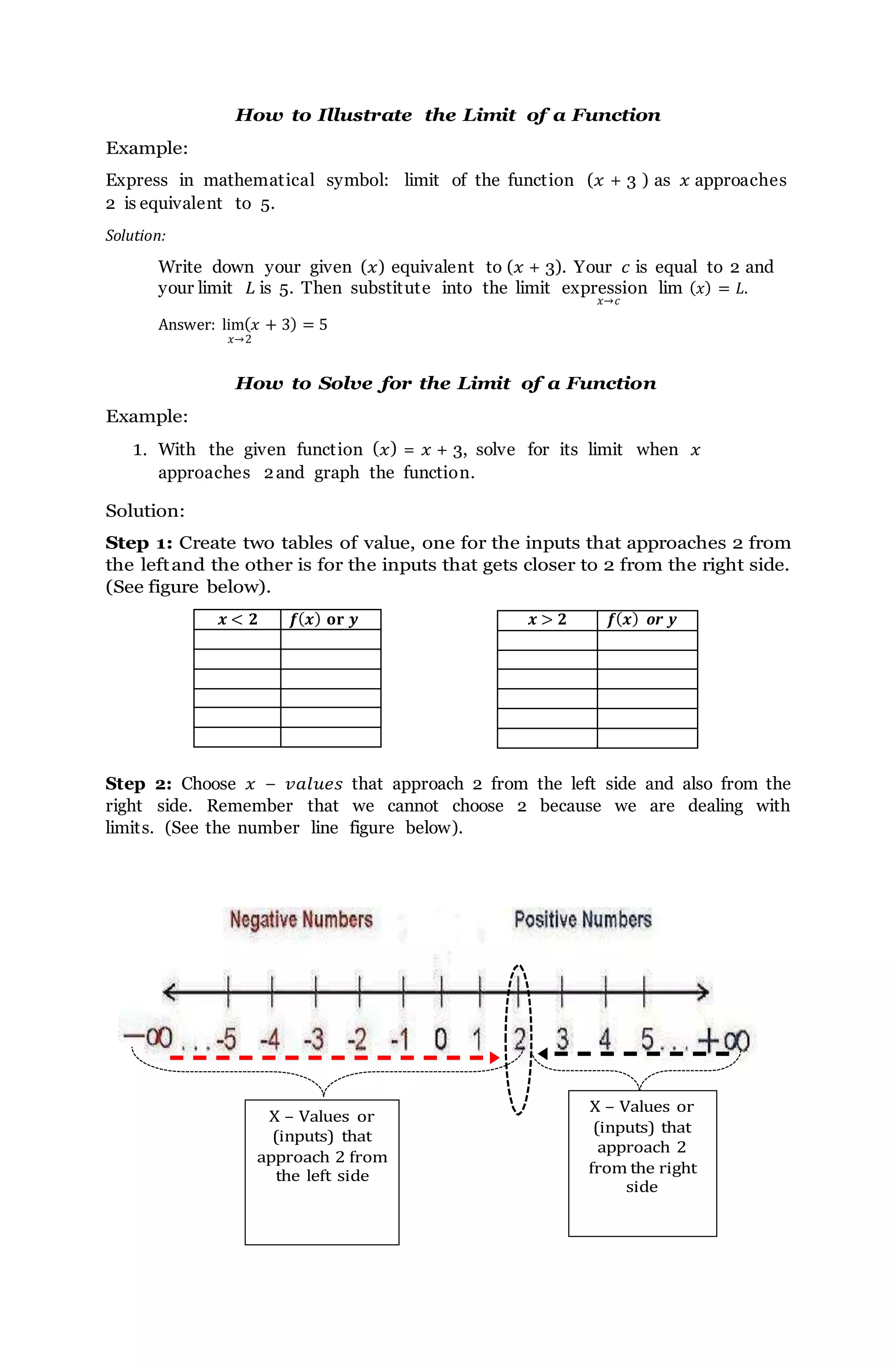
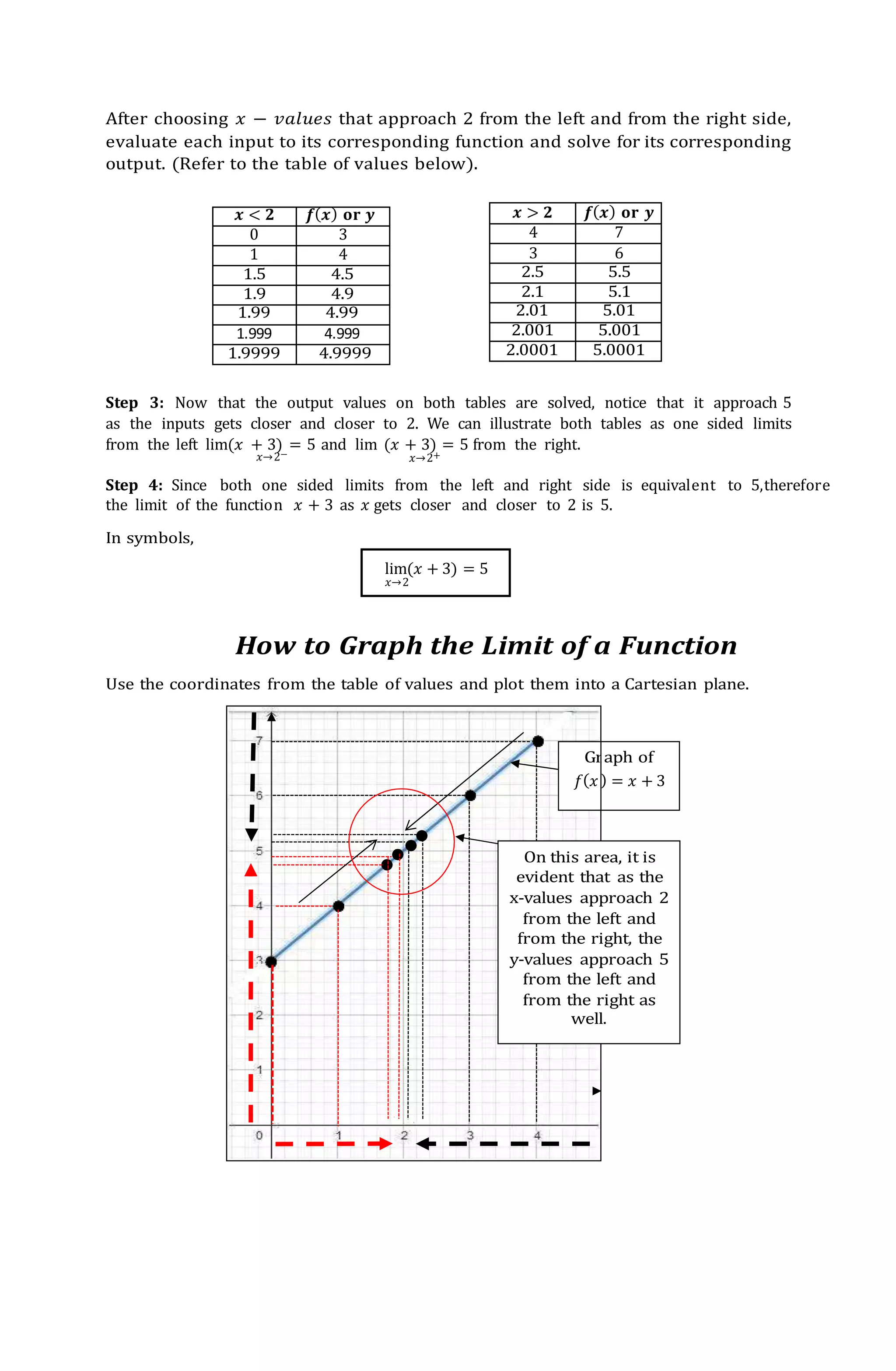
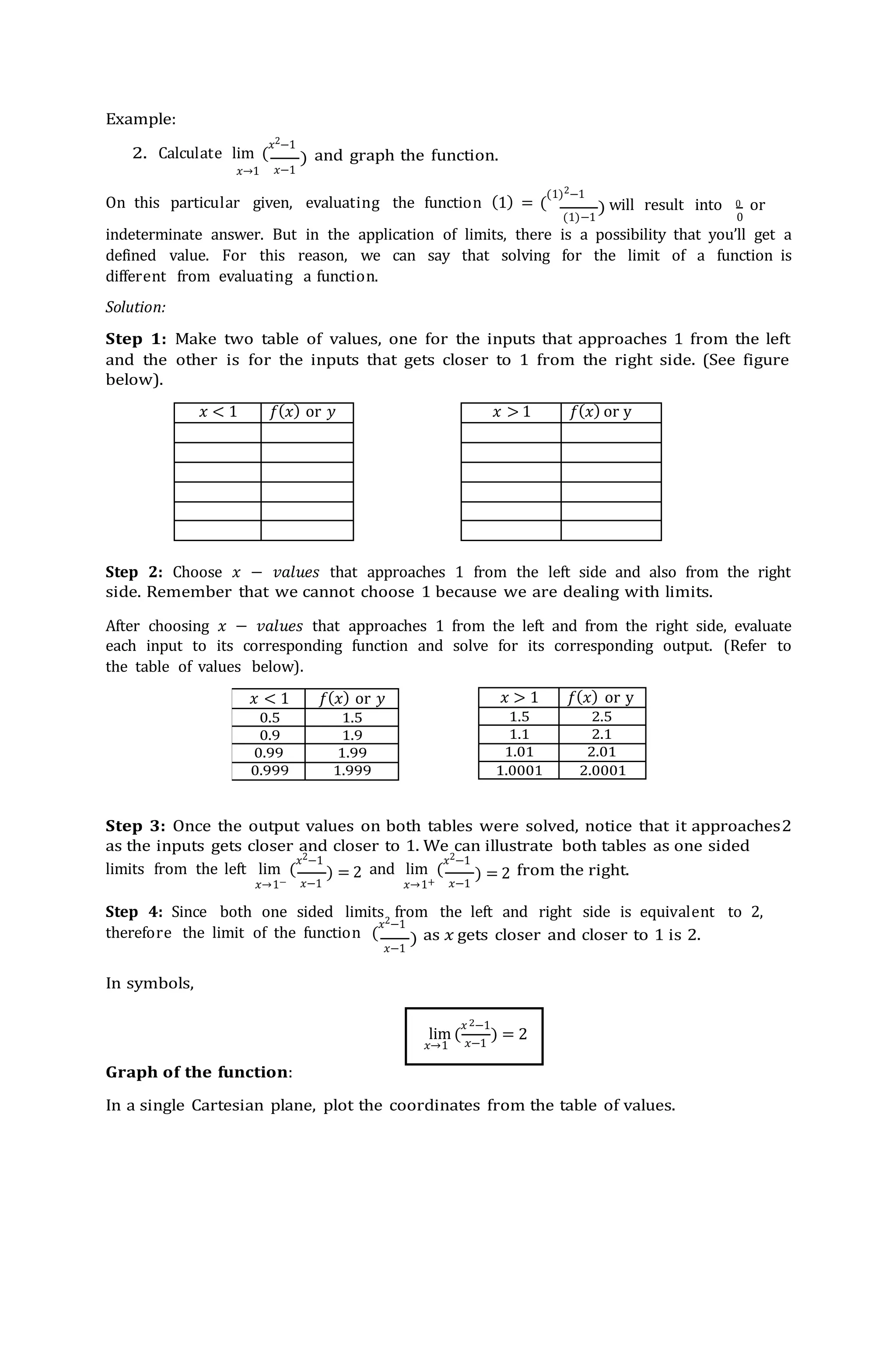
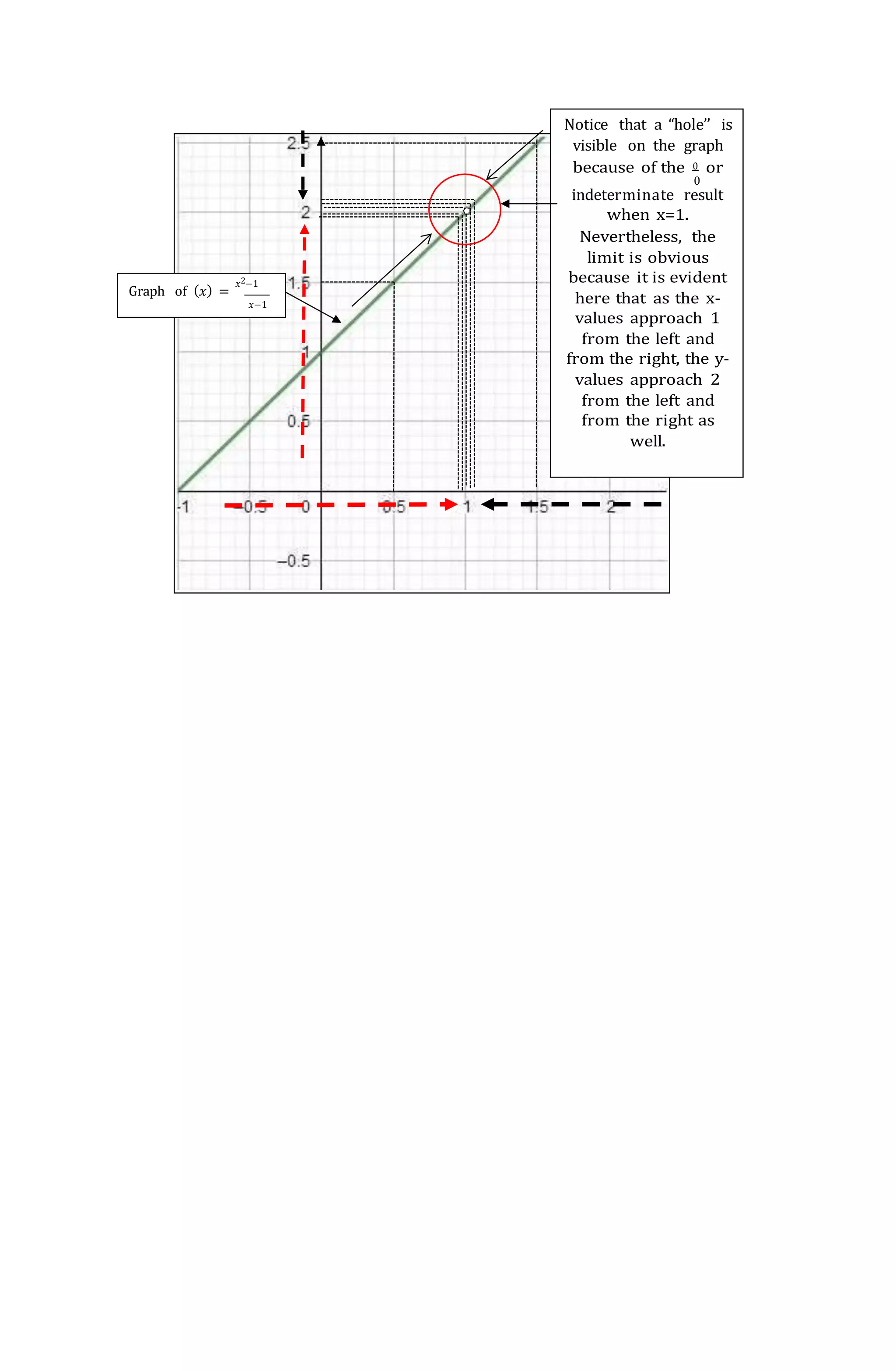
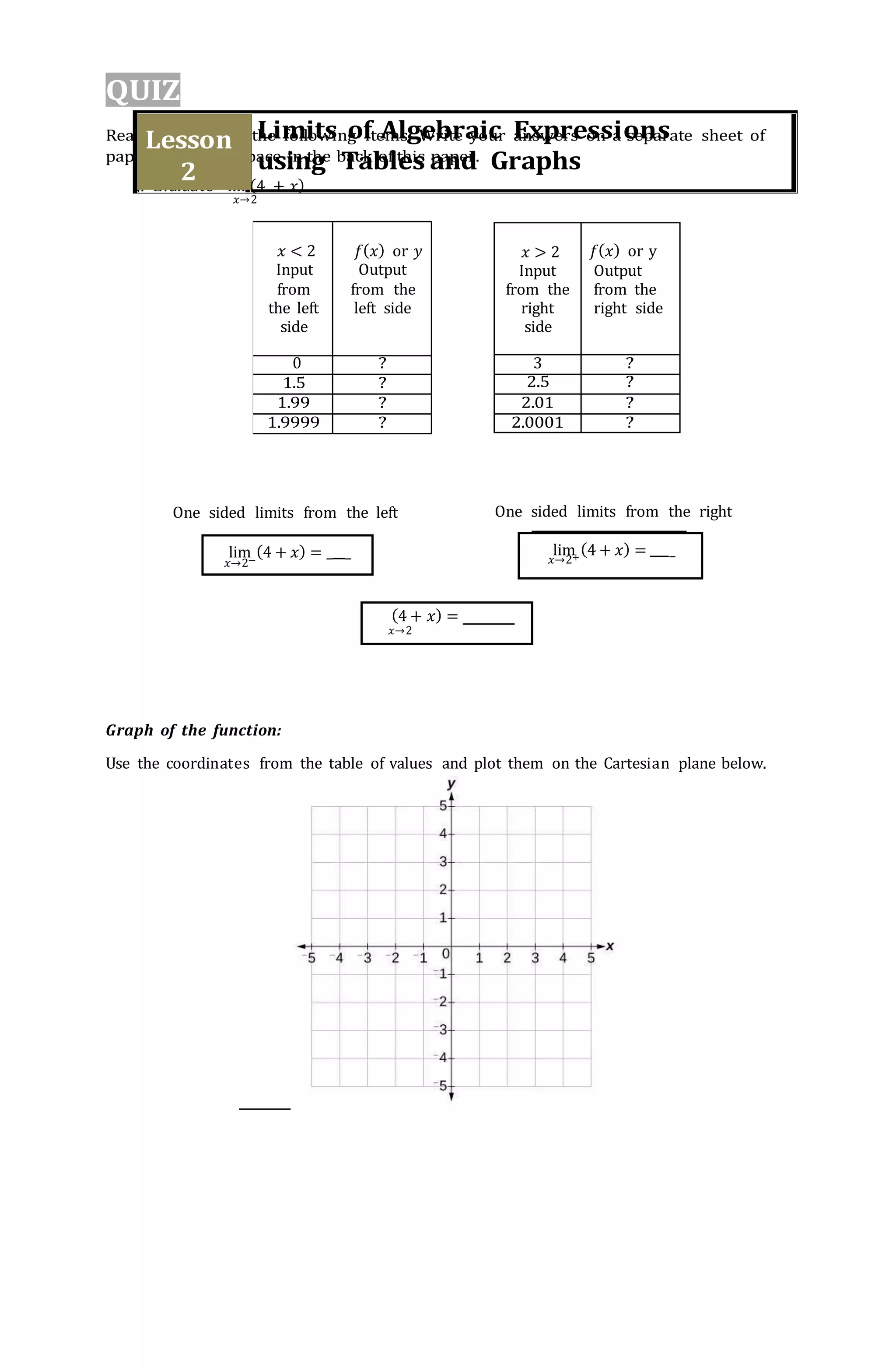

![Steps Solution
1. Observe the given function.
Since it is a rational function,
check whether its numerator
or denominator is factorable.
𝑥2 − 𝑥 − 6 = (𝑥 + _ )(𝑥 − _ )
2. Since the numerator is
factorable, it is evident that
(𝑥 − 3) can be divided.
lim
𝑥→3
|
(𝑥+2)(𝑥−3)
𝑥−3
|=
3. What is left is just (𝑥 + 2), since
it is a polynomial function;
direct substitution is
applicable because it has no
lim(𝑥 + 2)
𝑥→3
domain restrictions.
4. Perform the operation.
[(3) + 2] =
5. Indicate the final answer. lim
𝑥→3
(
𝑥2−𝑥−6
𝑥−3
)=
Limit laws are used as alternative ways in solving the limit of a function
withoutusing table of values and graphs.
Below are the different laws that can be applied in various situations to
solve for thelimit of a function.
A. The limit of a constant is itself. If k is any constant, then,
𝐥𝐢𝐦(𝒌) = 𝒌
𝒙→𝒄
Example:
1. lim(5) = 5
𝑥→𝑐
2. lim(−9) =−9
𝑥→𝑐
B. The limit of 𝑥 as 𝑥 approaches 𝑐 is equal to c. That is,
𝐥𝐢𝐦𝒙 = 𝑪
𝒙→𝒄
Examples:
1. lim (𝑥) = 8
𝑥→8
2. lim (𝑥) = −2
𝑥→−2](https://image.slidesharecdn.com/basic20cal20final-220923132100-ac603c77/75/Basic-20Cal-20Final-docx-docx-8-2048.jpg)
![ For the remaining theorems, we will assume that the limits of f and g
bothexist as x approaches c and that they are L and M, respectively. In other
words,
𝐥𝐢𝐦(𝒙) = 𝑳 and 𝐥𝐢𝐦(𝒙) = 𝑴
𝒙→𝒄 𝒙→𝒄
C. The Constant Multiple Theorem. The limit of a constant 𝑘 times a function is
equal to the product of that constant and its function’s limit.
[𝒌 ∙ 𝒇(𝒙)] = 𝒌 ∙ 𝐥𝐢𝐦 𝒇(𝒙) = 𝒌 ∙ 𝑳
𝒙→𝒄
Examples: If lim 𝑓(𝑥) = 3 , then
𝑥→𝑐
1. lim 5 . (𝑥) = 5 . lim 𝑓(𝑥) = 5 . 3 = 15
𝑥→𝑐 𝑥→𝑐
2. lim (−9). (𝑥) = (−9) . lim 𝑓(𝑥) = (−9) . 3 = −27
𝑥→𝑐 𝑥→𝑐
D. The Addition theorem. The limit of a sum of functions is the sum of the
limits of the individual functions.
𝐥𝐢𝐦 [ 𝒇(𝒙) + 𝒈(𝒙) ] = 𝐥𝐢𝐦 𝒇(𝒙) + 𝐥𝐢𝐦 𝒈(𝒙) = 𝑳 + 𝑴
𝒙→𝒄 𝒙→𝒄 𝒙→𝒄
Examples:
1. If lim 𝑓(𝑥) = 3 and lim 𝑔(𝑥) = −4, then
𝑥→𝑐 𝑥→𝑐
lim ( 𝑓(𝑥) + 𝑔(𝑥)) = lim 𝑓(𝑥) + lim 𝑔(𝑥) = 3 + (−4) = −1
𝑥→𝑐 𝑥→𝑐 𝑥→𝑐
2. If lim (𝑥) = −5 and lim (𝑥) = −2, then
𝑥→𝑐 𝑥→𝑐
lim( 𝑓(𝑥) + 𝑔(𝑥)) = lim 𝑓(𝑥) + lim 𝑔(𝑥) = −5 + (−4) = −9
𝑥→𝑐 𝑥→𝑐 𝑥→𝑐
E. The Subtraction Theorem. The limit of a difference of functions is the
difference of the limits of the individual functions.
𝐥𝐢𝐦 [ 𝒇(𝒙) − 𝒈(𝒙)] = 𝐥𝐢𝐦𝒇(𝒙) − 𝐥𝐢𝐦𝒈(𝒙) = 𝑳 − 𝑴
𝒙→𝒄 𝒙→𝒄 𝒙→𝒄
Examples:
1. If lim 𝑓(𝑥) = 3 and lim 𝑔(𝑥) = −4, then
𝑥→𝑐 𝑥→𝑐
lim ( 𝑓(𝑥) − 𝑔(𝑥)) = lim 𝑓(𝑥) − lim 𝑔(𝑥) = 3 − (−4) = 7
𝑥→𝑐 𝑥→𝑐 𝑥→𝑐
2. If lim (𝑥) = −5 and lim (𝑥) = −2, then
𝑥→𝑐 𝑥→𝑐
lim ( 𝑓(𝑥) − 𝑔(𝑥)) = lim 𝑓(𝑥) − lim 𝑔(𝑥) = −5 − (−4) = −1
𝑥→𝑐 𝑥→𝑐 𝑥→𝑐](https://image.slidesharecdn.com/basic20cal20final-220923132100-ac603c77/75/Basic-20Cal-20Final-docx-docx-9-2048.jpg)
![F. The Multiplication Theorem. The limit of a product of functions is the
product of the limits of the individual functions.
𝐥𝐢𝐦 [ 𝒇(𝒙) ∙ 𝒈(𝒙)] = 𝐥𝐢𝐦 𝒇(𝒙) ∙ 𝐥𝐢𝐦 𝒈(𝒙) = 𝑳 ∙ 𝑴
𝒙→𝒄 𝒙→𝒄 𝒙→𝒄
Examples:
1. If lim 𝑓(𝑥) = 3 and lim 𝑔(𝑥) = −4, then
𝑥→𝑐 𝑥→𝑐
lim( 𝑓(𝑥) . (𝑥)) = lim (𝑥) . lim 𝑔(𝑥) = (3)(−4) = −12
𝑥→𝑐 𝑥→𝑐 𝑥→𝑐
2. If lim (𝑥) = −5 and lim (𝑥) = −2, then
𝑥→𝑐 𝑥→𝑐
lim ( 𝑓(𝑥) . (𝑥)) = lim (𝑥) . lim 𝑔(𝑥) = (−5)(−4) = 20
𝑥→𝑐 𝑥→𝑐 𝑥→𝑐
G. The Division Theorem. The limit of a quotient of functions is the quotient
of the limits of the individual functions, provided that the denominator is not
equal to zero.
𝐥𝐢𝐦
𝒙→𝒄
[
𝒇(𝒙)
𝒈(𝒙)
] =
𝐥𝐢𝐦
𝒙→𝒄
𝒇(𝒙)
𝐥𝐢𝐦
𝒙→𝒄
𝒈(𝒙)
=
𝑳
𝑴
, 𝑴 ≠ 𝟎
Examples:
1. If lim
𝑥→𝑐
𝑓(𝑥) = 3 𝑎𝑛𝑑 lim
𝑥→𝑐
𝑔(𝑥) = −6 ,𝑡ℎ𝑒𝑛
lim
𝑥→𝑐
[
𝑓(𝑥)
𝑔(𝑥)
] =
lim
𝑥→𝑐
𝑓(𝑥)
lim
𝑥→𝑐
𝑔(𝑥)
=
3
−6
= −
1
2
2. If lim
𝑥→𝑐
𝑓(𝑥) = 0 𝑎𝑛𝑑 lim
𝑥→𝑐
𝑔(𝑥) = 7 ,𝑡ℎ𝑒𝑛
lim
𝑥→𝑐
[
𝑓(𝑥)
𝑔(𝑥)
] =
lim
𝑥→𝑐
𝑓(𝑥)
lim
𝑥→𝑐
𝑔(𝑥)
=
0
7
= 0
H. The Power Theorem. The limit of an integer power 𝑝 of a function is just
thatpower of the limit of the function.
𝐥𝐢𝐦
𝒙→𝒄
[𝒇(𝒙)]𝒑
= [𝐥𝐢𝐦𝐟
𝒙→𝒄
(𝒙)]
𝒑
= (𝑳)𝒑
Examples:
1. If lim
𝑥→𝑐
𝑓(𝑥) = 3, 𝑡ℎ𝑒𝑛
lim
𝑥→𝑐
[𝑓(𝑥)]4
= [lim f
𝑥→𝑐
(𝑥)]
4
= (3)4
= 81](https://image.slidesharecdn.com/basic20cal20final-220923132100-ac603c77/75/Basic-20Cal-20Final-docx-docx-10-2048.jpg)
![I. The Radical/Root Theorem. If 𝑛 is a positive integer, the limit of the
𝑛𝑡ℎ rootof a function is just the 𝑛𝑡ℎ root of the limit of the function,
provided that the 𝑛𝑡ℎ root of the limit is a real number.
𝐥𝐢𝐦
𝒙→𝒄
√𝒇(𝒙)
𝒏
= 𝐥𝐢𝐦
𝒙→𝒄
√𝐥𝐢𝐦
𝒙→𝒄
𝒇(𝒙)
𝒏
= √𝑳
𝒏
Examples:
1. If lim
𝑥→𝑐
𝑓(𝑥) = 8 , 𝑡ℎ𝑒𝑛
lim
𝑥→𝑐
√𝑓(𝑥)
3
= lim
𝑥→𝑐
√lim
𝑥→𝑐
𝑓(𝑥)
3
= √8
3
= 2
2. If lim
𝑥→𝑐
𝑓(𝑥) = 64 , 𝑡ℎ𝑒𝑛
lim
𝑥→𝑐
√𝑓(𝑥) = lim
𝑥→𝑐
√lim
𝑥→𝑐
𝑓(𝑥) = √64 = 8
More examples:
1. Find: lim (𝑥2 + 4𝑥 − 3)
𝑥→4
Solution:
Steps Solution
1. Apply Addition Law Theorem. lim(𝑥2) + lim(4𝑥) + lim(−3)
𝑥→4 𝑥→4 𝑥→4
2. Apply Power Theorem on the
first term.
2
[lim 𝑥] + lim(4𝑥) + lim(−3)
𝑥→4 𝑥→4 𝑥→4
3. Apply Multiplication Theorem
on the second term.
2
[lim 𝑥] + 4 [lim 𝑥] + lim(−3)
𝑥→4 𝑥→4 𝑥→4
4. Apply the limit of 𝑥 as
𝑥 approaches 𝑐 is equal to c.
42 + 4(4) + lim(−3)
𝑥→4
5. Apply the limit of a constant is
the constant itself. 42 + 4(4) + (−3)
6. Simplify. 16 + 16 − 3 = 29](https://image.slidesharecdn.com/basic20cal20final-220923132100-ac603c77/75/Basic-20Cal-20Final-docx-docx-11-2048.jpg)
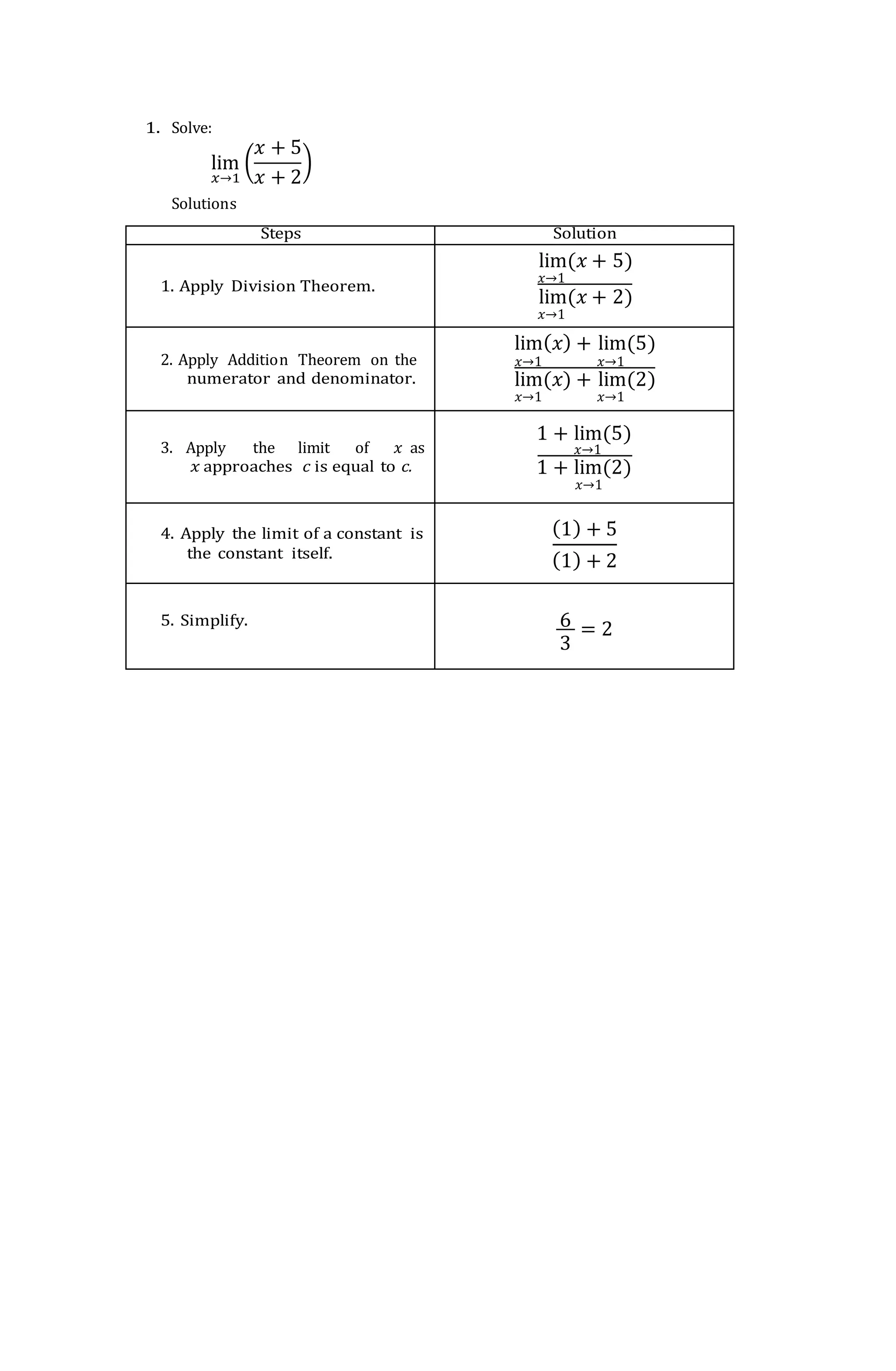
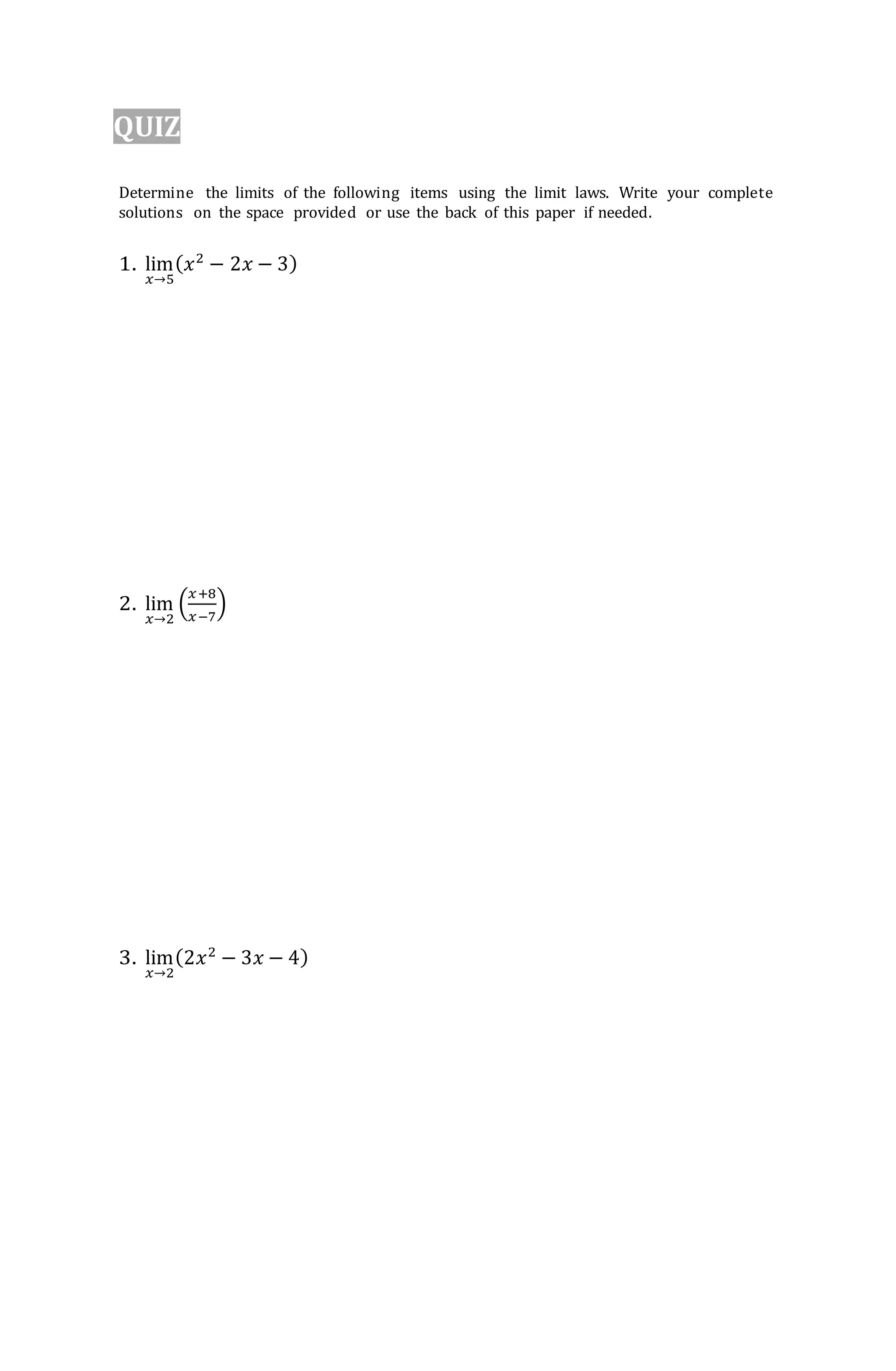
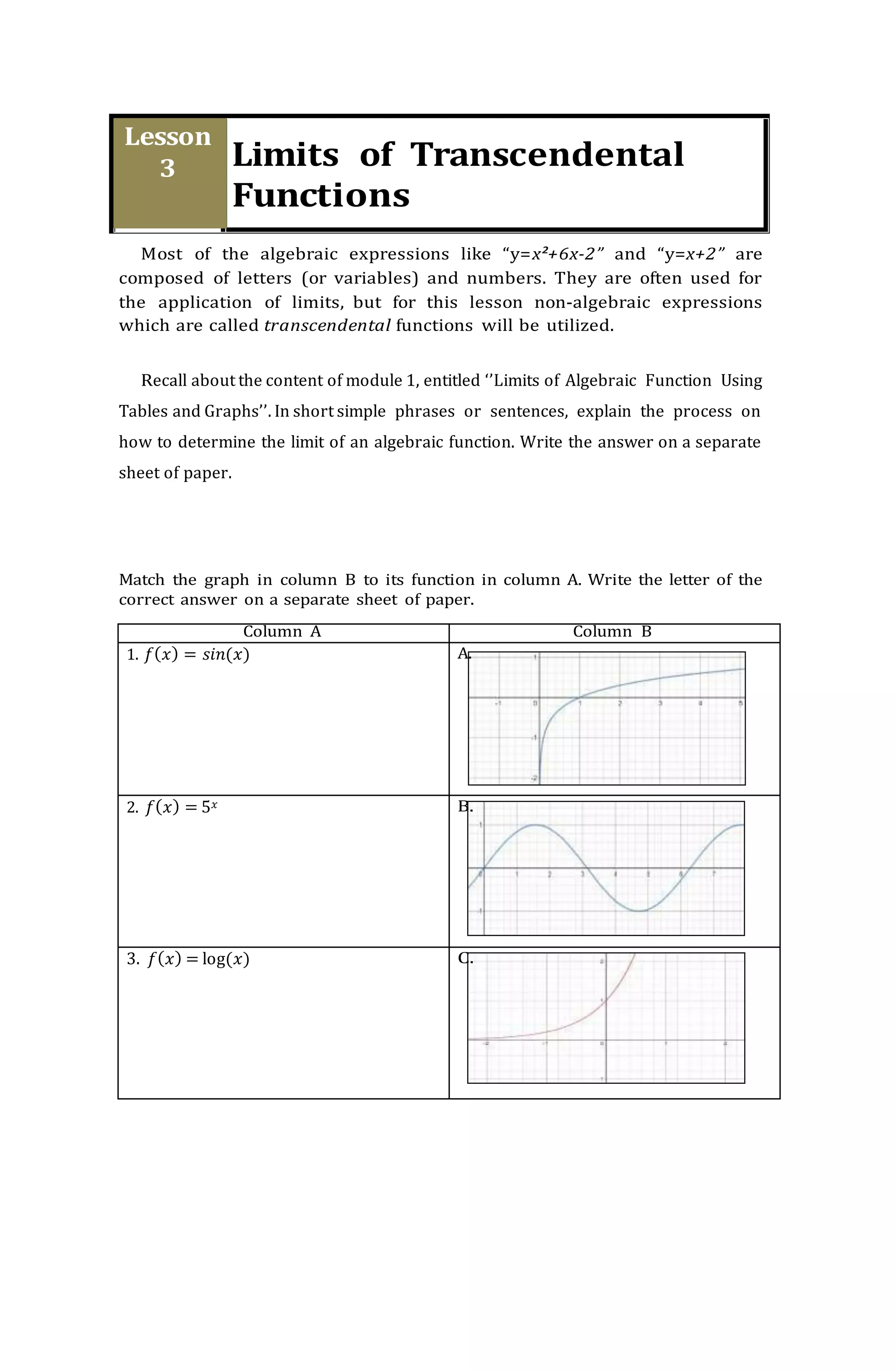
![For this lesson, we are going to find the limit of a transcendental function
instead of algebraic. Transcendental functions are functions that cannot be
expounded in algebraic form. Some examples of transcendental functions are
exponential [(𝑥) = 10𝑥+1], logarithmic [(𝑥) = log(𝑥 − 2)] and trigonometric
[ℎ(𝑥) = sin(𝑥 + 3)] functions.
The method that will be used in solving the limit of transcendental
function is also table of values and graphs.
Example 1: Exponential function
1. Solve the lim [2(𝑥)] using table of values and sketch its graph.
𝑥→2
SOLUTION:
Create two tables for 𝒙 value that approaches 2 from the left and from the right.
Table 1.
𝒙 1.7 1.9 1.99 1.999
𝒚 3.249009585 3.732131966 3.972369982 3.997228372
Table 2.
𝒙 2.001 2.005 2.01 2.1
𝒚 4.00277355 4.013886994 4.0278222 4.28709385
Observation: As the 𝒙 value approaches 2 from the left and right, the 𝒚 value
approaches 4.
After the 𝒚 values on both tables were solved, determine the one-sided limits
from the left and right side.
lim
𝑥→2−
3(𝑥)
= 9 lim
𝑥→2+
3(𝑥)
= 9
Since both one-sided limits from the left and right is equivalent to 9, therefore
thelimit of the function 𝟑𝒙 as 𝒙 gets closer to 2 is 9.
The limit is written as, lim 3𝑥
= 9.
𝑥→2
To illustrate the limit of the function through graph, plot all coordinates from](https://image.slidesharecdn.com/basic20cal20final-220923132100-ac603c77/75/Basic-20Cal-20Final-docx-docx-15-2048.jpg)
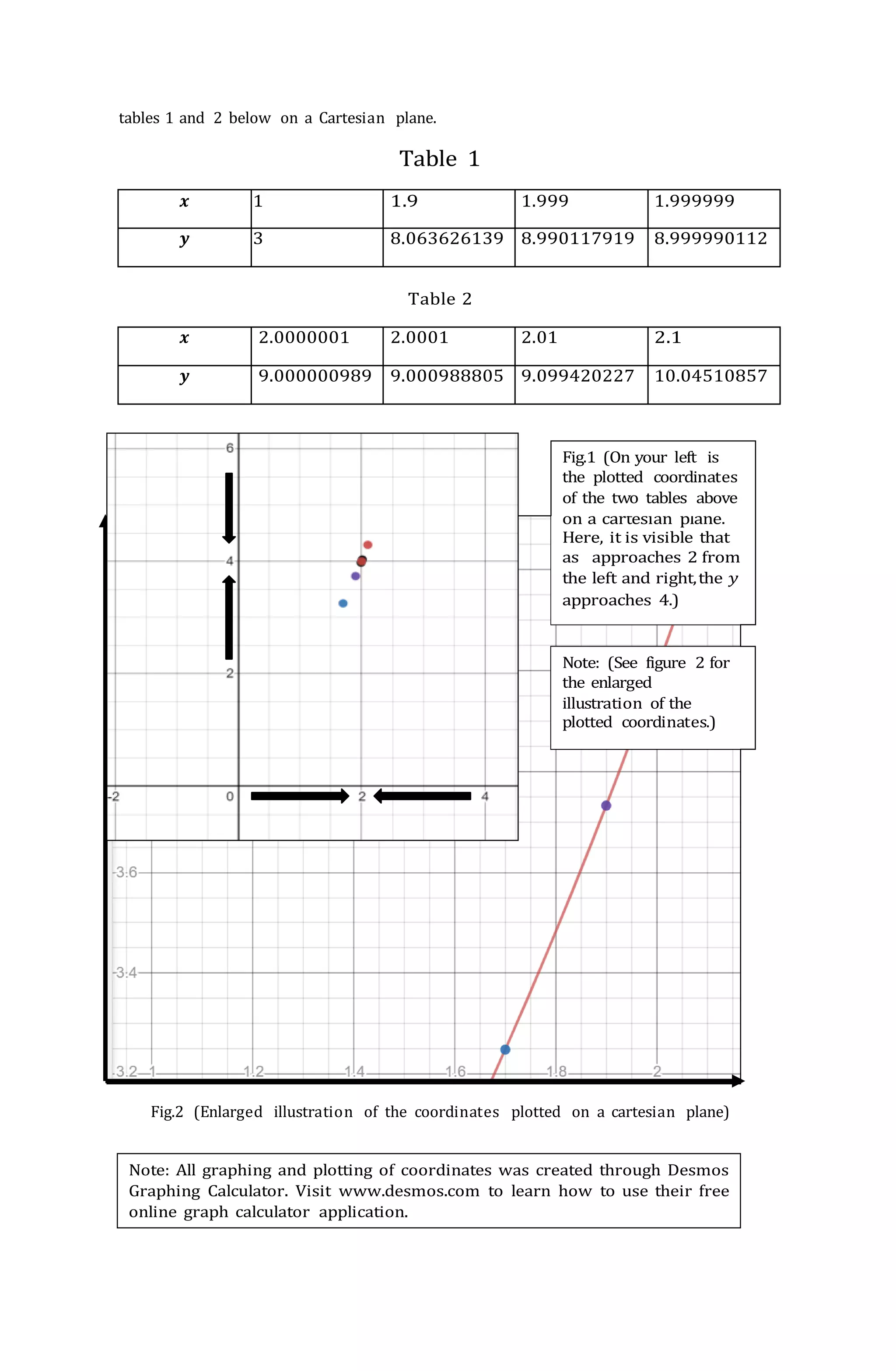
![Example 2: Logarithmic function
1. Find lim[log3(𝑥)] using table of values and sketch its graph.
𝑥→1
SOLUTION:
Create two tables for 𝒙 value that approaches 1 from the left and from the right.
Table 3.
𝒙 0.8 0.9 0.99
𝒚 -0.203114013 -0.095903274 -0.009148209
Table 4.
𝒙 1.001 1.01 1.1
𝒚 -0.00090978441 0.00905718146 0.086755064
Observation: As the 𝒙 value approaches 1 from the left and right, the 𝒚 value
approaches 0.
After the 𝒚 values on both tables were solved, determine the one-sided limits from
the left and right side.
lim log3(𝑥) = 0 lim log3(𝑥) = 0
𝑥→1− 𝑥→1+
Since both one-sided limits from the left and right is equivalent to 0, therefore
thelimit of the function log3(𝑥) as 𝒙 gets closer to 1 is 0.
The limit is written as lim [log3(𝑥)] = 0 .
𝑥→1
To illustrate the limit of the function through graph, plot all coordinates from
tables3 and 4 on a cartesian plane.
Table 3
𝒙 0.8 0.9 0.99
𝒚 -0.203114013 -0.095903274 -0.009148209](https://image.slidesharecdn.com/basic20cal20final-220923132100-ac603c77/75/Basic-20Cal-20Final-docx-docx-17-2048.jpg)
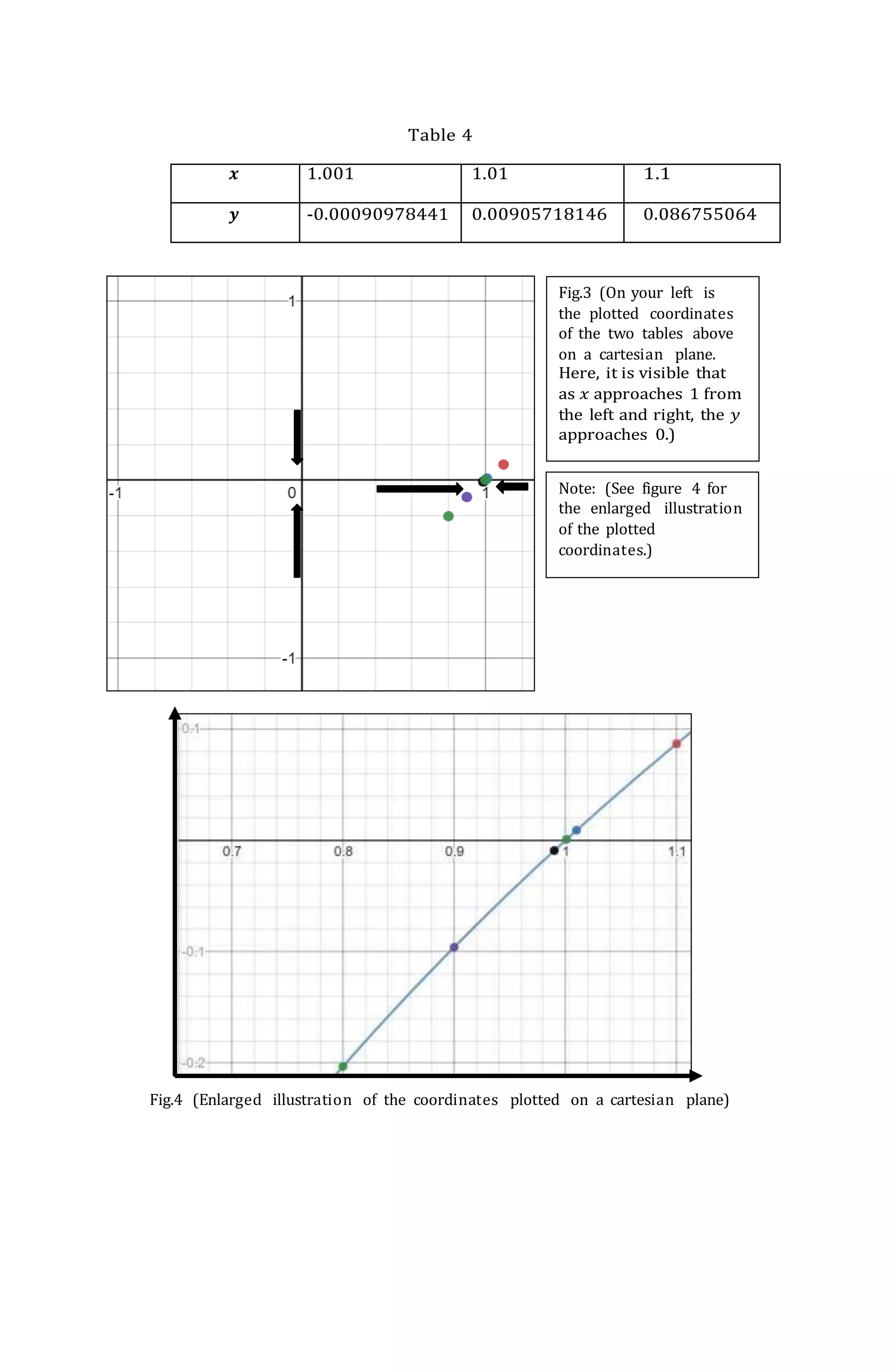
![sin (𝑡)
𝒕
Example 3: Trigonometric function
1. Evaluate lim[ ] using table of values and sketch its graph.
𝑡→0 𝑡
SOLUTION:
Create two tables for 𝒕 value that approaches 0 from the left and from the right.
Onthis example, 𝒕 was used instead of the variable 𝒙.
Table 5.
𝒕 -0.5 -0.2 -0.01
𝒚 0.958851077 0.993346654 0.999983333
Table 6.
𝒕 0.01 0.2 0.5
𝒚 0.999983333 0.993346654 0.958851077](https://image.slidesharecdn.com/basic20cal20final-220923132100-ac603c77/75/Basic-20Cal-20Final-docx-docx-19-2048.jpg)
![Note: (See figure 7 for the
enlarged illustration of
the plotted coordinates.)
Observation: As the 𝑡 value approaches 0 from the left and right, the
𝒚 valueapproaches 1.
After the 𝒚 values on both tables were solved, determine the one-sided limits
from the left and right side.
l
i
m
[
sin(𝑡)
] = 1 lim [
sin(𝑡)
] = 1
𝑡→0− 𝑡 𝑡→0+ 𝑡
Since both one-sided limits from the left and right is equivalent to 1, therefore
thelimit of the function sin(𝑡) as 𝑡 gets closer to 0 is 1.
𝑡
The limit is written as lim [
sin(𝑡)
] = 1 .
𝑡→0 𝑡
To illustrate the limit of the function through graph, plot all coordinates from
tables5 and 6 on a cartesian plane.
Table 5
𝒕 -0.5 -0.2 -0.01
𝒚 0.958851077 0.993346654 0.999983333
Table 6
𝒕 0.01 0.2 0.5
𝒚 0.999983333 0.993346654 0.958851077
Fig.6 (On your left is the
plotted coordinates of the
two tables above on a
cartesian plane. Here, it
is visible that as 𝑡
approaches 0 from the
left and right, the 𝑦
approaches 1.)](https://image.slidesharecdn.com/basic20cal20final-220923132100-ac603c77/75/Basic-20Cal-20Final-docx-docx-20-2048.jpg)
![NOTE: Refer to example 3 for the note about conversion from degree
to radian mode on a scientific calculator
Fig.7 (Enlarged illustration of the coordinates plotted on a cartesian plane)
Example 4: Trigonometric function
1. Sol
ve
1−cos (𝑡)
lim [ ] using table of values and sketch its graph.
𝑡→0 𝑡
SOLUTION:
Create two tables for 𝒕 value that approaches 0 from the left and from the
right.Again, 𝑡 was used instead of the variable 𝒙.
Table 7.
𝒕 -0.5 -0.2 -0.01
𝒚 -0.244834876 -0.09966711 -0.0049999583
Table 8.
𝒕 0.01 0.2 0.5
𝒚 0.0049999583 0.09966711 0.244834876](https://image.slidesharecdn.com/basic20cal20final-220923132100-ac603c77/75/Basic-20Cal-20Final-docx-docx-21-2048.jpg)
![Observation: As the 𝒕 value approaches 0 from the left and right, the 𝒚
valueapproaches 0.
After the 𝒚 values on both tables were solved, determine the one-sided limits from
the left and right side.
l
i
m
[
1−cos(𝑡)
] = 0 lim [
1−cos(𝑡)
] = 0
𝑡→0− 𝑡 𝑡→0+ 𝑡
Since both one-sided limits from the left and right is equivalent to 0, therefore
thelimit of the function 1−cos(𝑡) as 𝑡 gets closer to 0 is 0.
𝑡
The limit is written as lim [
1−cos(𝑡)
] = 0 .
𝑡→0 𝑡
To illustrate the limit of the function through graph, plot all coordinates from
tables7 and 8 on a cartesian plane.
Table 7
𝒕 -0.5 -0.2 -0.01
𝒚 -0.244834876 -0.09966711 -0.0049999583
Table 8
𝒕 0.01 0.2 0.5
𝒚 0.0049999583 0.09966711 0.244834876
Note: (See
figure 9 for the
enlarged
illustration of
the plotted
coordinates.)
Fig.8 (On your
left is the
plotted
coordinates of
the two tables
above on a
cartesian plane.
Here, it is
visible that as 𝑡
approaches 0
from the left
and right, the 𝑦
approaches 0.)](https://image.slidesharecdn.com/basic20cal20final-220923132100-ac603c77/75/Basic-20Cal-20Final-docx-docx-22-2048.jpg)
![Fig.9 (Enlarged illustration of the coordinates plotted on a cartesian plane)
Example 5: Exponential function
5. Determine lim
𝑡→0
[
𝑒𝑡
𝑡
] using table of values and sketch its graph.
SOLUTION:
Create two tables for 𝒕 value that approaches 0 from the left and from the
right.Again, 𝒕 was used instead of the variable 𝒙.
Table 9.
𝒕 -0.5 -0.2 -0.01
𝒚 0.78693868 0.906346234 0.995016624
Table 10.
𝒕 0.01 0.2 0.5
𝒚 1.005016708 1.107013791 1.297442541](https://image.slidesharecdn.com/basic20cal20final-220923132100-ac603c77/75/Basic-20Cal-20Final-docx-docx-23-2048.jpg)
![Note: (See figure 11
for the enlarged
illustration of the
plotted coordinates.)
Observation: As the 𝒕 value approaches 0 from the left and right, the 𝒚
valueapproaches 1.
After the 𝒚 values on both tables were solved, determine the one-sided limits from
the left and right side.
lim
𝑡→0−
[
𝑒𝑡
𝑡
] = 1 lim
𝑡→0+
[
𝑒𝑡
𝑡
] = 1
Since both one-sided limits from the left and right is equivalent to 0, therefore the
limit of the function 𝑒
𝑡-1
𝑡
as 𝒕 get closer to 0 is 1.
The limit is written as lim
𝑡→0
[
𝑒𝑡
𝑡
] = 1
To illustrate the limit of the functionthrough graph, plot all coordinates fromtables 9 and 10
on a cartesian plane.
Table 9
𝒕 -0.5 -0.2 -0.01
𝒚 0.78693868 0.906346234 0.995016624
Table 10
𝒕 0.01 0.2 0.5
𝒚 1.005016708 1.107013791 1.297442541
Fig.10 (On your left is
the plotted
coordinates of the two
tables above on a
cartesian plane. Here,
it is visible that as 𝑡
approaches 0 from
the left and right, the
𝑦 approaches 1.)](https://image.slidesharecdn.com/basic20cal20final-220923132100-ac603c77/75/Basic-20Cal-20Final-docx-docx-24-2048.jpg)
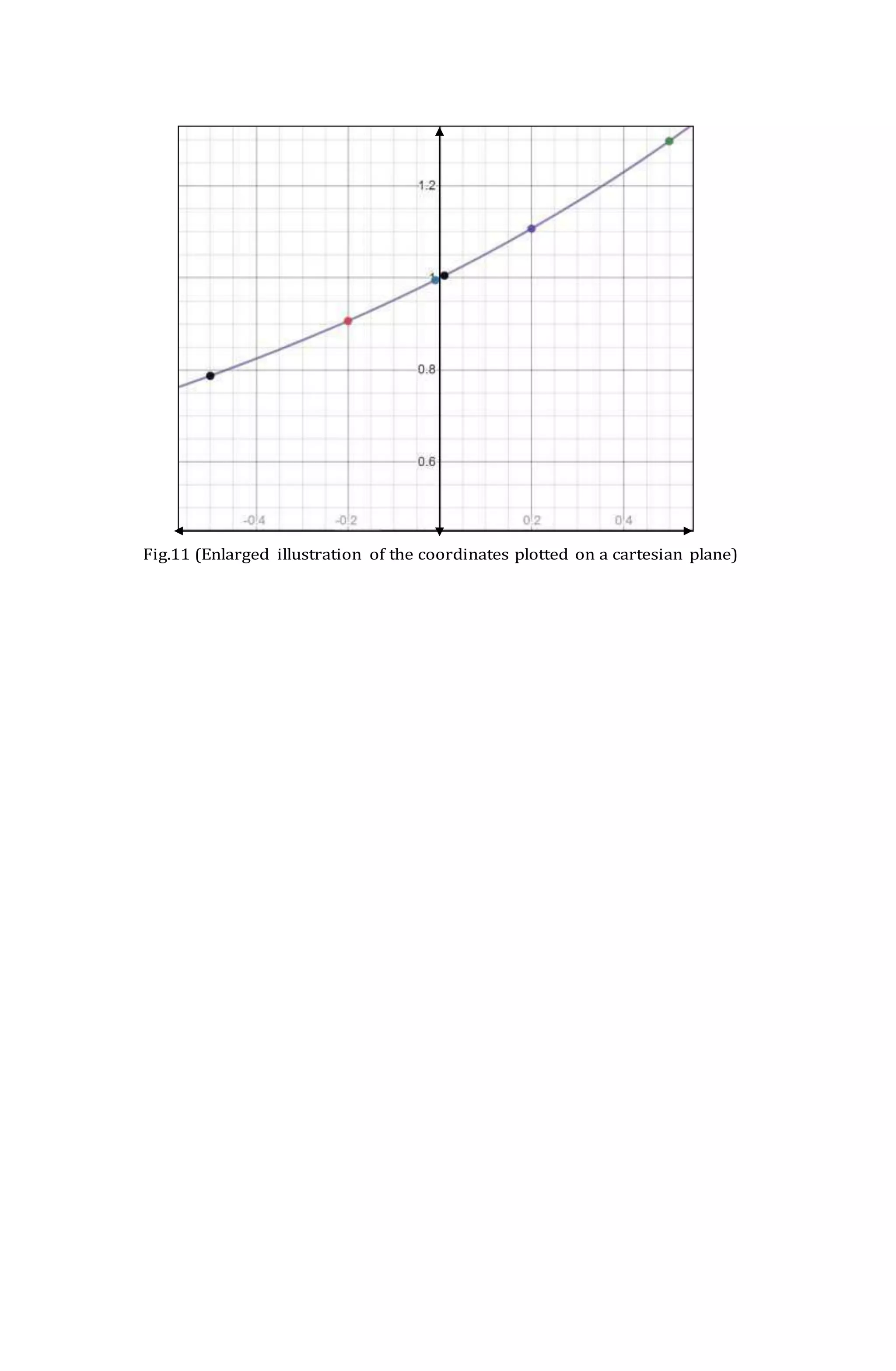
![26
QUIZ
Answer the following items below. Write your answer on a separate sheet of paper
or use the space at the back of this paper.
1. Evaluate the lim [ln (𝑥)] using table of values.
𝑥→1
Table A (for 𝑥 values that approaches 1 from the left)
𝒙 0.5 0.9 0.999
𝒚
Table B (for 𝑥 values that approaches 1 from the right)
𝒙 1.001 1.01 1.1
𝒚
2. Illustrate the lim [ln (𝑥)] by plotting all coordinates from tables A and B on
a
𝑥→1
cartesian plane.](https://image.slidesharecdn.com/basic20cal20final-220923132100-ac603c77/75/Basic-20Cal-20Final-docx-docx-26-2048.jpg)

